User Guide
Table of Contents
- Table of Contents
- Introduction
- About the User Guide
- Quick Start
- About TinS
-
Features
- Opens the Home Page :
home - Opens the Statistics Page :
stats - Opens the Calendar Page :
calendar - Adding an Internship Application :
add - Listing all Internships Applications :
list - Finding Internships:
find - Viewing Details of a Particular Internship Application :
select - Editing Details of Internship Application :
edit - Deleting an Internship Application :
delete - Event Commands
- Finding all Clashing Events :
clash - Clearing all Internship Applications in TinS :
deleteall - Getting Help :
help - Exiting the program :
exit - Saving the data
- Opens the Home Page :
- Command Summary
- Acknowledgements
The Intern's Ship - User Guide

Introduction
Designed with internship-seeking university students in mind, The Intern’s Ship (TinS) aims to make managing your internship applications fuss-free. Despite being optimised for use via the keyboard, you will still be able to enjoy the benefits of having a visual display.
With TinS, you can conveniently and efficiently manage, coordinate and keep track of your internship applications all in one place.
Notable Features
- Finding a particular internship application in TinS using keywords:
find - Finding a particular event in TinS using keywords:
event find - Calendar View:
calendar - Finding all clashing events:
clash
About the User Guide
Objective of User Guide
The Objective of this User Guide is to provide you with useful instructions on how to navigate the TinS application. To ensure a smooth on-boarding process to The Intern’s Ship, this User Guide will include detailed step-by-step instructions on how to install the TinS application into your device, as well as how to use the various features of TinS. If you are a frequent user of TinS, this User Guide will also include useful tips on how you can use TinS in a more efficient way.
How the User Guide is Formatted
Additional Tips and Comments
Information Box
Tip Box
Warning Box
Syntax Highlighting
Commands, fields, prefixes and file paths are highlighted in the User Guide.
Example: list, POSTIION, data/internshipcatalogue.json
How to use the User Guide
- If you have not installed TinS or are new to TinS, Quick Start will guide you through the process of installing TinS and provide you with a brief introduction to TinS.
- If you are a more advanced user of TinS, the Features section contains detailed information of what features TinS has to offer. Embedded in this section is also tips on how you can maximize your efficiency while using TinS.
Quick Start
-
Ensure you have Java
11or above installed in your Computer. -
Download the latest
tins.jarfrom here. -
Copy the file to the folder you want to use as the home folder for your TinS.
 Info: A home folder is the folder you would like TinS to use to store all your internship
application data and relevant files to TinS. You can choose to use any existing folder you have or create a new
empty folder.
Info: A home folder is the folder you would like TinS to use to store all your internship
application data and relevant files to TinS. You can choose to use any existing folder you have or create a new
empty folder.
-
Double-click on the file
tins.jarto launch TinS. A TinS Application Interface similar to the one below should appear in a few seconds.
 Tip: The default TinS application contains some sample data. If you are new to TinS, these sample
data can be useful for trying out the various commands of TinS. To remove all sample data, use the
Tip: The default TinS application contains some sample data. If you are new to TinS, these sample
data can be useful for trying out the various commands of TinS. To remove all sample data, use the
deleteall. - Type your command into the Command Box, then press to instruct TinS to execute your command.
Here are some basic commands you can try:
-
list: List all internships in the List Panel -
add p/Data Analyst c/Google s/0 d/NA t/IMPORTANT t/PRIORITY: Add an internship to TinS -
delete 1: Delete the first internship in the List Panel from TinS
-
- Refer to the Command Summary below for your desired TinS Commands. More details on each specific TinS command can be found here.
About TinS
About TinS Application’s Interface

- Command Box: This is where you would input your commands.
-
Program Response: This box displays the program’s feedback to your inputted commands.
Types of Program Response Messages:- Success Message: indicating that TinS has successfully executed your command
- Error Message: indicating the reason why TinS was not about to execute your command and tips on what you can do to correct the error
- List Panel: This panel displays your internships listings stored in TinS (including Position, Company, Status and Tags).
-
Display Panel: This panel is used to display more details. Depending on your given command, the Details could be
any one of the following:
- More details pertaining to a Specific Internship
- Pages: Home, Calendar View, Statistics
- Results of Commands, like
clashorevent find
- Location Bar: This location bar states the location in which your TinS data file is currently stored on your local device
How your Internship Application Data is Organised in TinS
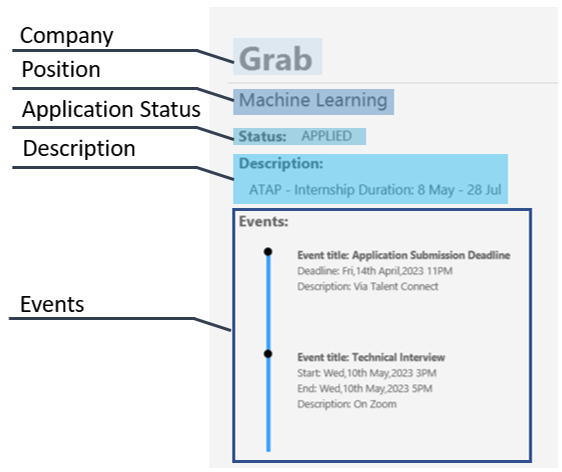
Internships
In TinS, an internship application is stored as an Internship. An Internship has the following fields:
-
POSITION: The Name of the Internship Position. -
COMPANY: The Name of the Hiring Company.
POSITION and
COMPANY. POSITION and COMPANY fields are case-insensitive. Example: An Internship with
POSITION as Software Engineer and COMPANY as Grab will be identified to be the
same internship as an Internship with POSITION as Software ENGINEER and COMPANY as GRAB.
-
STATUS: The Status of your Application. This is an Integer value from 0 to 3. Here are the statuses for the corresponding integer values:-
0: Interested -
1: Applied -
2: Offered -
3: Rejected
-
-
DESCRIPTION: Additional details about the Internship (E.g. Contact Details of Hiring Manager, Link to Internship Webpage, Requirements of Internship). This field is optional. -
TAG: Customised Tag (E.g.IMPORTANT,PRIORITY). An Internship can have zero or more tags. All tags in TinS are displayed in capitalised letters.-
TAGmust be alphanumeric (i.e. aTAGshould not contain any blank-spaces, hyphens, colons, dashes etc).
-
POSITION, COMPANY and TAG have a maximum
of 40 characters. While TinS will still allow the addition of entries with more than 40 characters, without
giving a warning, the addition of these fields could affect the visual display of TinS (i.e. truncated fields).
An Internship can also store zero or more Event.
Events
In TinS, an Event can be used to represent a Deadline or an Interview associated to an Internship.
- Deadline: An Event that only has an end timing (E.g. Internship Application Submission Deadline, Offer Acceptance Deadline)
- Interview: An Event that has both a start and end timing (E.g. Interview, Online Assessments)
An Event has the following fields:
-
EVENT_NAME: The Name of the Event.
EVENT_NAME have a maximum of 40 characters.
While TinS will still allow the addition of entries with more than 40 characters, without giving a warning, the
addition of this field could affect the visual display of TinS (i.e. truncated field).
-
START_DATETIME: The Starting Time of an Event (in the format: DD/MM/YYYY HHMM). -
END_DATETIME: The Ending Time of an Event (in the format: DD/MM/YYYY HHMM).- If the Event is a Deadline, the
START_DATETIMEwill be the same as theEND_DATETIME.
- If the Event is a Deadline, the
-
EVENT_DESCRIPTION: Description of the Event (e.g. Venue, Things to take note of). This field is optional.
Information about Crafting Your Command
This section contains information on how to craft your command.
Prefixes and Fields
TinS differentiates between the various fields in your command by its preceding prefix. The Prefixes are designed to be short, to enable you to quickly indicate which field your information is associated to. Here is the list of fields and their associated prefixes.
| Field | Prefix |
|---|---|
POSITION |
p/ |
COMPANY |
c/ |
STATUS |
s/ |
DESCRIPTION |
d/ |
TAG |
t/ |
EVENT_NAME |
na/ |
START_DATETIME |
st/ |
END_DATETIME |
en/ |
EVENT_DESCRIPTION |
de/ |
Example: If you input a
DESCRIPTION field as d/This is a my description p/field, TinS would recognise the
sequence p/ as an indicator for the POSITION field. Hence, the above input would be recognised as an input with
two fields, a DESCRIPTION field - d/This is a description and a POSITION field - p/field.
Notes about the Command Format
-
Command words are case-insensitive.
Example: The command
LISTis the same as the commandlist. -
Prefixes are case-sensitive.
Example: Entering the prefix
P/will not be recognised by TinS asp/ -
Words in
UPPER_CASEare the fields to be supplied by you.Example: in
add p/POSITION c/COMPANY s/STATUS [d/DESCRIPTION] [t/TAGS]...,POSITIONis a parameter which can be used asadd p/Software Engineer c/Grab s/1 d/Requires python t/IMPORTANT. -
Items in square brackets are optional.
Example:
[d/DESCRIPTION]means inadd p/POSITION c/COMPANY s/STATUS [d/DESCRIPTION] [t/TAG]...means the commandsadd p/Software Engineer c/Grab s/0andadd p/Software Engineer c/Grab s/0 d/This is a descriptionare both valid. -
Items with
...after them can be used multiple times including zero times.Example:
[t/TAG]...inadd p/POSITION c/COMPANY s/STATUS [d/DESCRIPTION] [t/TAG]...means the commandadd p/Software Engineer c/Grab s/0 d/This is a descriptionandadd p/Software Engineer c/Grab s/0 d/This is a description t/IMPORTANT t/PRIORITYare valid. -
Items without
...after them should only be used once. Warning: If an item without
Warning: If an item without ...after it is used more than once, TinS will identify the last occurrence of that item as the input for that field.
Example:add p/POSITION c/COMPANY s/STATUS [d/DESCRIPTION] [t/TAG]...means that the item,p/POSITIONshould only be used once. Hence, ifadd p/Software Engineer c/Grab s/0 d/This is a description t/IMPORTANT p/Data Analyst p/Machine Learningis entered, TinS would identify the input for the fieldPOSITIONasMachine Learning. -
Fields can be in any order.
Example:
add p/POSITION c/COMPANY s/STATUS [d/DESCRIPTION] [t/TAG]...is the same asadd c/COMPANY s/STATUS [d/DESCRIPTION] p/POSITION [t/TAG]... -
If the command does not require you to input a field, any extra field/values enter after the identified command is ignored.
The commands in TinS that do not require additional input of fields from user are
list,clash,home,calendar,stats,helpandexit.Example: If
clash helpis entered, TinS will identify your command as aclashcommand, ignoring all the extra fields/values found afterclash, and execute the commandclash.
Features
Opens the Home Page : home
Opens the Home Page in the Display Panel.
Format: home
home command can also be used to refresh the Home Page in the Display Panel.
- Home Page reminds you of your upcoming deadlines and interviews, occurring either today or tomorrow, and the command format for useful commands, by conveniently displaying them in the Display Panel.
Example:

Opens the Statistics Page : stats
Calculates statistics based on your current internship applications and displays personalized statistics in the Display Panel.
Format: stats
stats command can also be used to refresh the Statistic Page in the Display Panel.
- Statistics Page shows you a summary of how your internship-seeking journey has been. The pie chart provides you with a visual representation of the current status of your internship applications.
Example:
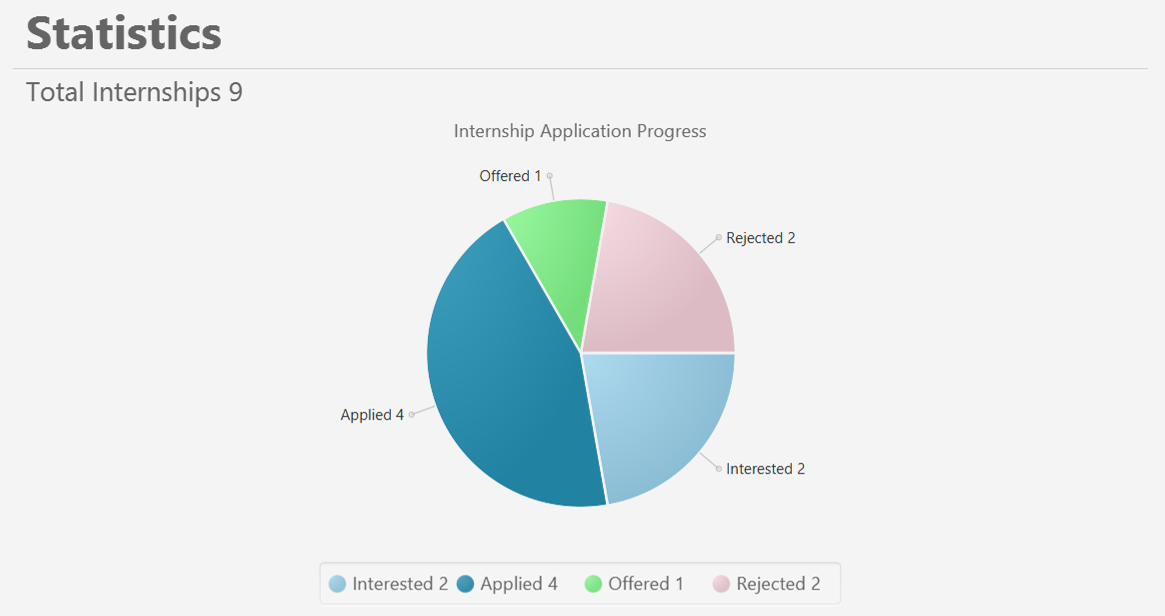
Opens the Calendar Page : calendar
Displays a calendar view of all your events in the Display Panel.
Format: calendar
calendar command can also be used to refresh the Calendar Page in the Display Panel.
- Clicking on an event displayed in the calendar view shows you more details about the event.
event find function to find events by
their start and end timings.
Example:
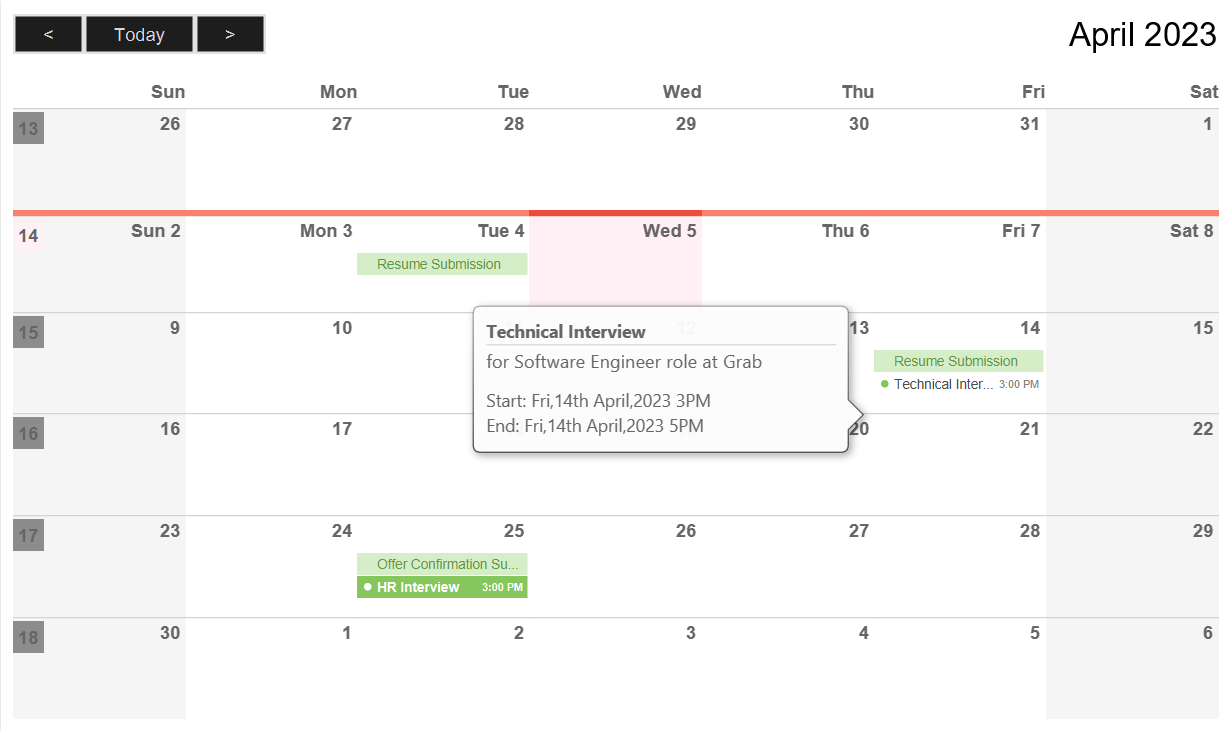
Adding an Internship Application : add
Adds an internship and its details to TinS.
Format: add p/POSITION c/COMPANY_NAME s/APPLICATION_STATUS [d/DESCRIPTION] [t/TAG] ...
POSITION and COMPANY fields, you would not be able to add an
internship application to TinS, if there is a pre-existing internship in TinS with the same POSITION and COMPANY
(comparison is case-insensitive). Example: If TinS contains an Internship with
POSITION as Software Engineer and COMPANY as Grab, the commands
add p/Software Engineer c/Grab s/0 and add p/SOFTWARE engineer c/Grab s/3 are not allowed.
t/important, TinS will automatically save it as t/IMPORTANT for you.
Example: add p/Software Engineer c/Grab s/1 d/Requires knowledge of Python and Java t/Important t/Priority
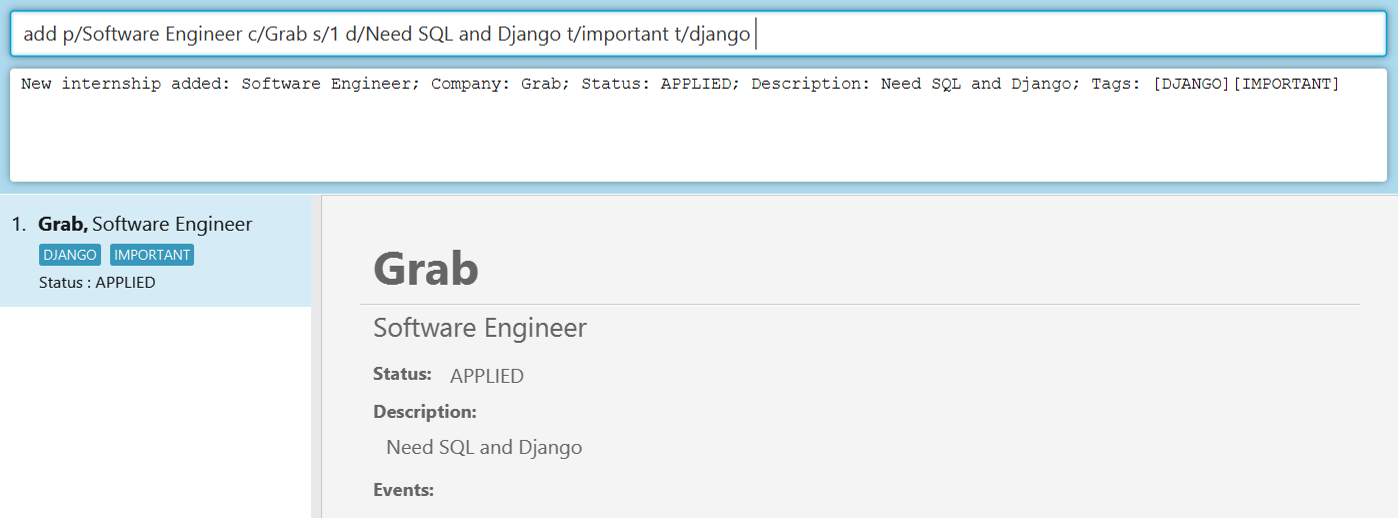
Listing all Internships Applications : list
List all the internships in List panel.
Format: list
- After keying in the
listcommand, TinS displays all the Internships stored in TinS in the List panel. - Only the
POSITION,COMPANY,STATUSandTAGare display in the List Panel for each Internship.
Example:
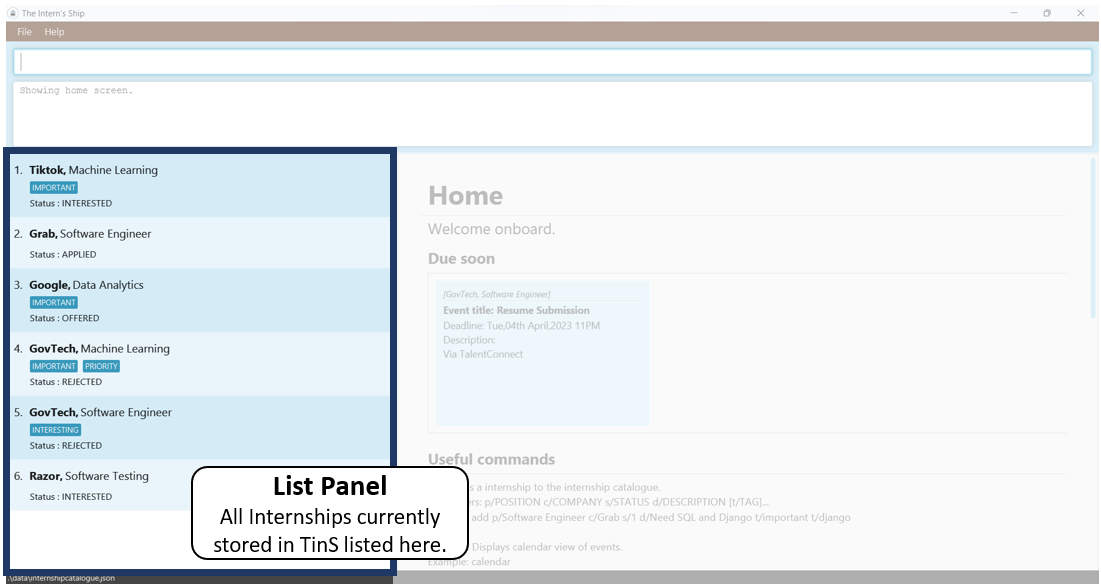
Finding Internships: find
Finds an Internships by their fields (POSITION, COMPANY, STATUS, TAG).
Format: find [p/POSITION] [c/COMPANY] [s/STATUS] [t/TAG]...
- Choose the fields you would like to filter the Internship Catalogue by. At least one field must be chosen, but more than one field can be chosen.
- If your chosen field is
POSITIONorCOMPANY, TinS will find all internship containing your given keyword in thePOSITIONorCOMPANYfield. This search is case-insensitive. - If your chosen field is
STATUS, TinS will find all internships with theSTATUSindicated in your command. - If your chosen field is
TAG, TinS will find all internships with all theTAGfields indicated in your command. This search is case-insensitive.
find t/, TinS will return all internships with no TAG field.
- After keying in your
findcommand, TinS will find internships that fulfil all your requirements given, displaying them in the List Panel. - To view all Internship in TinS again, simply enter the
listcommand.
Example: TinS has 7 internship listings. find c/tech t/important would return the list of internships with COMPANY
containing the word “gov” and TAG as IMPORTANT.
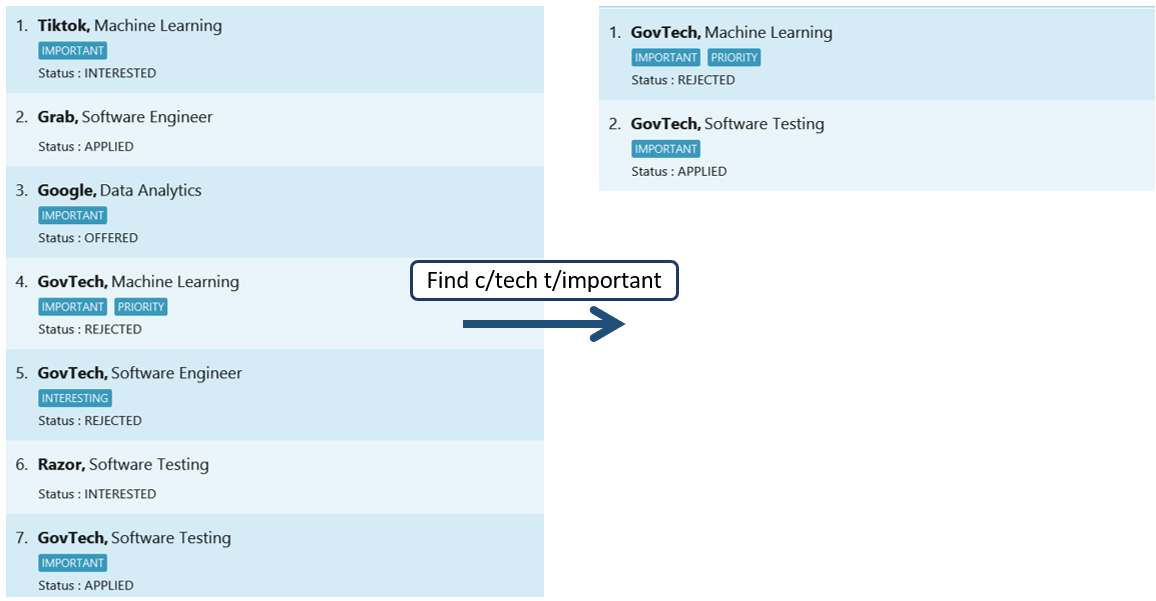
Viewing Details of a Particular Internship Application : select
View more details of the internship application selected by ID.
Format: select ID
-
ID: The number of the selected internship in the List Panel. - After keying in the
selectcommand, TinS will return the all details of the selected internship in the Display Panel.
Example: select 2
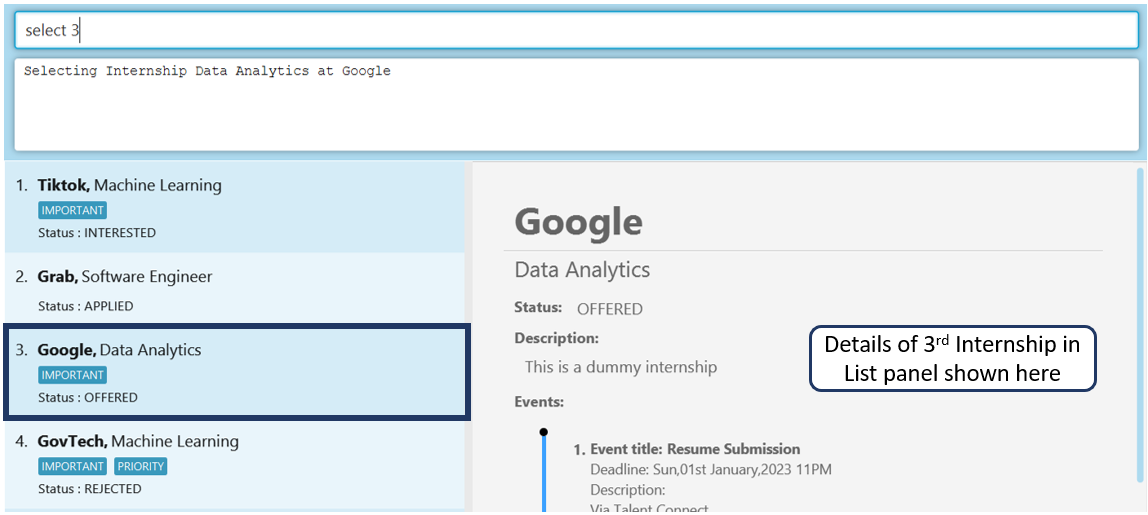
Editing Details of Internship Application : edit
Edit details of the internship application selected by ID.
Format: edit ID [p/POSITION] [c/COMPANY] [s/STATUS] [d/DESCRIPTION] [t/TAG] ...
-
ID: The number of the selected internship in the List Panel. - Choose one or more fields to edit.
- After keying in the
editcommand, along with your new edited fields, TinS will update the corresponding fields of the internship application accordingly.
TAG field in TinS would remove all existing TAG associated with the
selected internship, and attach your newly indicated TAG fields to your selected internship.Example: If the 1st internship in the list panel has the
TAG fields, IMPORTANT and PRIORITY, the command
edit 1 t/GOOD will modify the TAG field of the internship to contain GOOD only.
Example:
After keying in the edit command followed by an existing ID and the fields STATUS and DESCRIPTION,
TinS will update the STATUS and DESCRIPTION fields of the internship application with the specified
ID, then display the newly updated internship application. The command edit 1 s/1 d/Learn C++ will return the
following results.
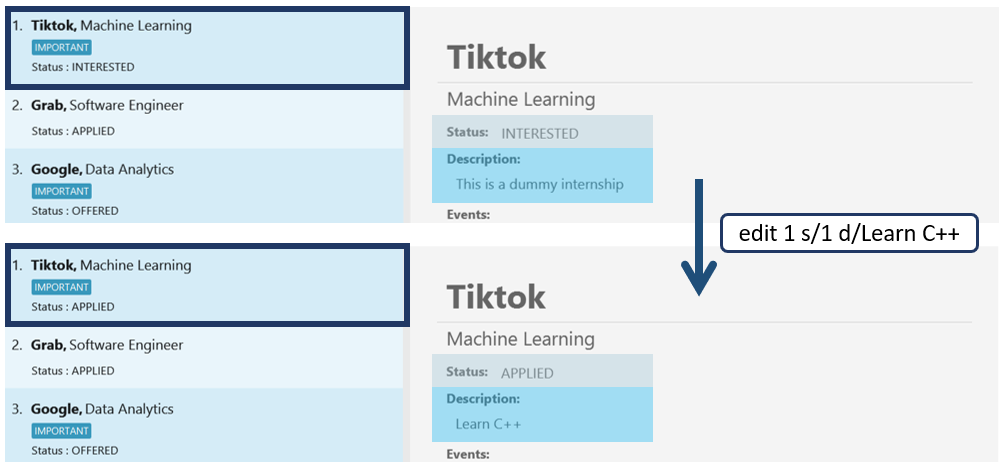
Deleting an Internship Application : delete
Deletes an internship along with its details by ID.
Format: delete ID
-
ID: The number of the selected internship in the List Panel. - Deletes the internship application at the specified
IDin the List Panel.
Example: delete 3 deletes the 3rd internship listed in the List Panel. In this example, the
internship application with POSITION as Data Analytics and COMPANY as Google is removed.
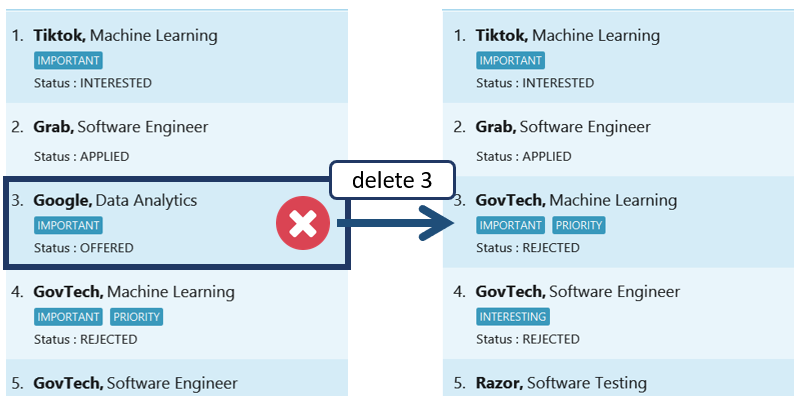
Event Commands
This section contains commands to manage your events associated with each internship application.
Adding an Event to an Internship Application : event add
Adds an Event along with its details to the selected internship.
select ID.
EVENT_NAME, START_DATETIME and END_DATETIME.
Format: event add na/EVENT_NAME [st/START_DATETIME] en/END_DATETIME [de/EVENT_DESCRIPTION]
-
START_DATETIMEandEND_DATETIMEfields need to be in the format : DD/MM/YYYY HHMM
event add enables you to add events even if the events occurred in the past.
Examples:
- If you would like to add an Internship Application Submission Deadline:
event add na/Application Submission Deadline en/14/04/2023 2359 de/Via Talent Connect - If you would like to add an Interview:
event add na/Technical Interview st/10/05/2023 1500 en/10/05/2023 1700 de/On Zoom
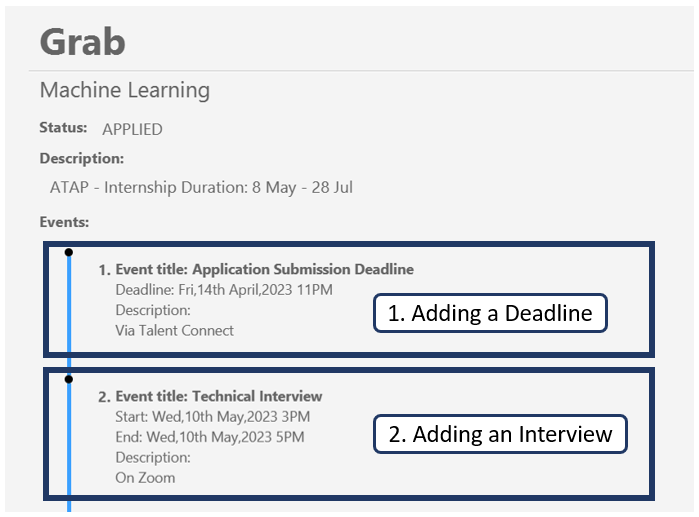
Deleting an Event from an Internship Application : event delete
Deletes selected Event along with its details from the selected internship.
select ID.
Format: event delete ID
-
ID: The ID of the selected event in the list
Examples: event delete 1 entered after select 1 deletes the first event in the first internship.
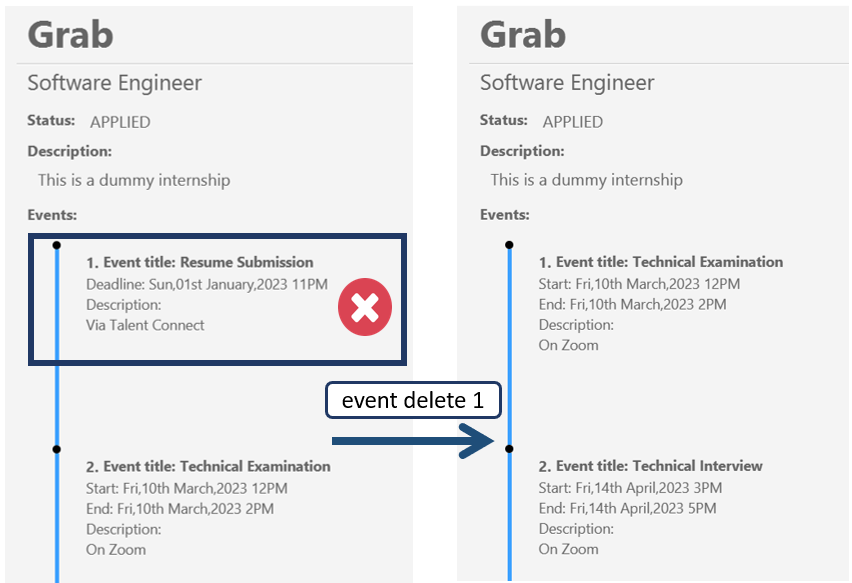
Finding a particular Event : event find
Finds events based on certain filters.
Format: event find [na/EVENT_NAME] [st/START_DATETIME] [en/END_DATETIME]
- Choose the fields you would like to filter the events by. At least one field must be chosen, but more than one field can be chosen.
- If your chosen field is
EVENT_NAMEfield, TinS will find all events containing your given keyword in theEVENT_NAMEfield. This search case-insensitive. - If your chosen field is
START_DATETIMEandEND_DATETIME, enter aDATETIMEin the format DD/MM/YYYY HHMM. TinS will find events with the correspondingSTART_DATETIMEorEND_DATETIME. - After keying in your
event findcommand, TinS will find events that fulfil all your requirements given, displaying them in the Display Panel.
Example: event find na/interview st/14/04/2023 1400 returns a list of events with EVENT_NAME containing the keyword
“interview” and starting time 14 April 2023, 2pm.

Finding all Clashing Events : clash
Displays all events with clashing timings in the Display Panel.
- Clashing Event are arranged by date.
- Two events are clashing if they are Interview events and have overlapping start and end timings.
- Clicking on a particular date, you will be able to see all events with clashing timings occuring on that date.
Format: clash
Example:

Clearing all Internship Applications in TinS : deleteall
Deletes all existing Internship Applications and Events in TinS.
- When you enter the command
deleteall, TinS will prompt you to double confirm that you would like to delete all Internship Applications and Events currently stored in TinS. - To proceed with executing the command, enter
deleteall confirm.
deleteall command can come in handy if you need to delete all the dummy data initially stored in
TinS or to reset the data in TinS in preparation for your next Internship Application season.
deleteall confirm directly, without first entering deleteall, TinS will delete
all internship application and events in TinS immediately. Hence, you are advised to avoid entering the command
deleteall confirm directly.
Format: deleteall
Getting Help : help
Provides you with a link to helpful instructions on how to use TinS.
Format: help
Example:

Exiting the program : exit
Exits and closes the TinS application.
Format: exit
Saving the data
The Intern Ship’s data is saved in the hard disk automatically after any command that changes the data. There is no need to save manually.
Command Summary
| Action | Format |
|---|---|
| Home Page | home |
| Statistics Page | stats |
| Calendar View | calendar |
| Add |
add p/POSITION c/COMPANY s/STATUS [d/DESCRIPTION] [t/TAG]...E.g. add p/Software Engineer c/Grab s/1 d/Requires knowledge of Python t/Important t/Priority
|
| List | list |
| Find |
find [p/POSITION] [c/COMPANY] [s/STATUS] [d/DESCRIPTION] [t/TAG]...E.g. find c/tech t/important would return the list of internships with COMPANY containing the
word “gov” and TAG as IMPORTANT
|
| Select |
select IDE.g. select 1 selects the first internship in the List Panel |
| Edit |
edit ID [p/POSITION] [c/COMPANY] [s/STATUS] [d/DESCRIPTION] [t/TAG]...E.g. edit 1 p/Data Analyst edits the POSITION of first internship in the List Panel
to Data Analyst
|
| Delete |
delete IDE.g. delete 1 deletes the first internship in the List Panel |
| Add Event |
select ID, then event add na/EVENT_NAME [st/START_DATETIME] en/END_DATETIME
[de/EVENT_DESCRIPTION]E.g. select 1, then event add na/Technical Interview st/10/09/2023 1500 en/10/09/2023 1700
de/On Zoom adds the event to the first internship in List Panel |
| Delete Event |
select ID, then event delete IDE.g. select 1, then event delete 1 deletes the first event from the first internship
listed in the List Panel |
| Find Event |
event find [na/EVENT_NAME] [st/START_DATETIME] [en/END_DATETIME]E.g. event find na/Technical Interview st/20/03/2023 1400
|
| Clash | clash |
| Delete All |
deleteall, followed by deleteall confirm
|
| Help | help |
| Exit | exit |
Acknowledgements
- The Intern’s Ship is written in Java 11.
- The Intern’s Ship uses the following libraries: JavaFX, Jackson, Junit5, CalendarFX
- The Intern’s Ship is adapted from addressbook-level3
- The Intern’s Ship - User Guide references the following projects: addressbook-level4, InternBuddy (for Markdown Formatting of the Information, Tip and Warning Box)